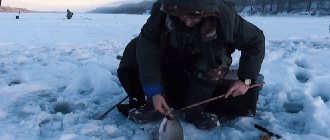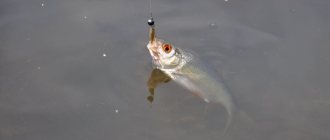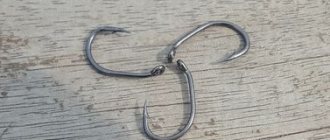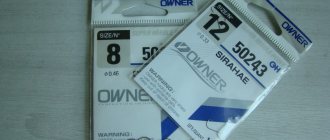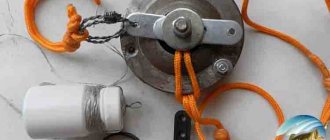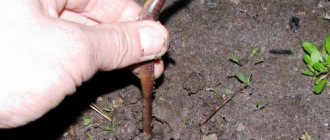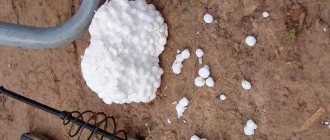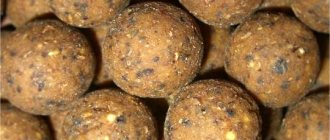Animal bait
Baits of animal origin work throughout the year, but the best results are shown when the water does not warm above 15 degrees. The fisherman must ensure that the bait he uses is fresh and attractive to fish. When going fishing, you need to have a supply of animal bait with you, which will come in handy if the fish bite well. The most common animal baits for catching bream include:
- muckworm;
- crawling worm;
- maggot;
- bloodworm.
The dung worm is the best bait for bream, working both in open water and when fishing from ice. For fishing, worms about 8 cm long are used. Since bream loves voluminous baits, 3-4 worms are placed on the hook. In order for the bait to hold well and all bites to be realized, you should use hooks No. 6-4 (according to the international classification), with a long shank and special notches. The number of bites will increase if you add chopped worms to the bait.
Crawling is a super bait for trophy-sized bream, which has proven itself well when fishing at night. This bait is mined in clay soil using a shovel, which requires a lot of labor. With the least amount of effort, crawlers can be stocked at night when the worms crawl to the surface. When fishing with a crawler, large hooks No. 4–1 are used. When hooked, the bait is pierced several times, leaving the sting open.
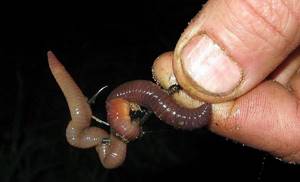
Maggot is a universal bait that attracts fish in both warm and cold water. Often used in combination with bloodworms or worms. Larvae colored yellow or red work better in muddy water. You can color the bait the desired color using food coloring. If fishing is carried out on a river where caddis flies are found, green-colored maggots will show good results. Large specimens of bream often prefer to peck on sleeping, floating maggots. To make such a nozzle you will need:
- place the larvae in a container and add a small amount of water, so that the maggots are half immersed in the liquid;
- leave the larvae drenched in water for 10 minutes;
- Pour boiling water over the maggots.
Floating larvae do not sink into soft muddy soil and always remain clearly visible to fish. Small bream are excellently caught on casters, which are pupae that are formed as a result of the transition of the larva to the adult insect phase. For fishing for maggots, hooks No. 14–8 are used. 5–8 larvae are placed on a hook.
Bloodworms are the best bait for bream in cold water. This is a delicate nozzle that requires special storage conditions. Bloodworms are stored in a humid environment at a temperature no higher than 5 degrees. For bream fishing, large larvae are selected, which are placed on a hook in 6-12 pieces. For fishing with bloodworms, hooks No. 16–12, made of thin wire, are used.
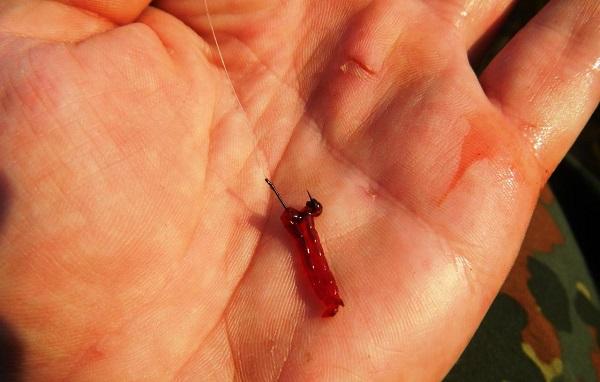
Maggot
Maggot bait occupies an important place among bream delicacies and works especially well when added to bait.
Cut or whole maggots are added to the bait during the starting feeding, and during the fishing process in the feeder. After some time, the bream will taste the larvae on the bottom and begin to actively respond to the baited hook. If there is a large consumption of maggots and if you have the desire and opportunity, you can stock up on your own maggots.
Live maggots on the bottom can distract bream from the baited hook. Therefore, some sports fishermen advise adding “submerged” maggots to the bait.
The maggots are poured with a small amount of water and kept in it for about 30 minutes. The larvae “sink” and become motionless. Among such immobile larvae, bream will be more attracted to live maggots on a hook.
Bream are caught well on maggot bait in warm weather, but not in all water bodies. If there are a lot of roach, silver bream and other small fish in the fishing sector, then the bream will not be able to be properly placed on the spot using bait with maggots. If this is important, then you can use other baits.
How to attach maggots to bream
The hard skin of the larvae will immediately reveal the degree of sharpness of the hook. A new high-quality sting pierces the larva immediately without resistance. If not, then the hook needs to be changed.
For catching bream, it is better when 3-4 maggots are placed on the hook. It is this kind of presentation at the bottom among the bait that provokes the bream to bite.
The hard skin of the maggot may not be liked by the inactive husk. If the bite is bad, when the fish sucks on the bait, this skin can be softened. You just need to roll the larva between your fingers, pressing down just a little. This will make it more motionless and softer.
Alternating colored and white maggots in the bait and kicks on the hook can additionally attract bream.
Today, in many fishing stores, among the baits, in addition to white maggots, they sell red and yellow ones. Often baited with colored grubs alone or in combination will attract bream better. Colored grubs release bait on the bottom and are practically proven to be effective when the bite is weak.
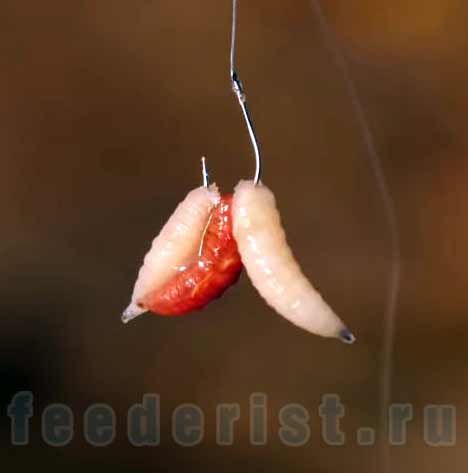
Hooks for maggots
The sharpness of the sting is the most important thing when planting these larvae. A good hook should pierce the skin like a hot knife through butter. If not, then you need to change it or look for another model. For bait with maggots, hooks with thin wire and a short sting are suitable.
Many models for bloodworms are also suitable for maggots, you just need to go one size larger. For example, you can buy the following hook models:
- Gamakatsu series LS-1810, LS-2210, LS-1310, LS-2030 No. 10-12;
- Owner of a series of hooks Chinta 50340, Funa 50563 numbers No. 10-12,
- Flagman Grand Feeder Skimmer And Zope Series 1, Series 2, Series 3.
These same hooks can also be used for sandwich bait.
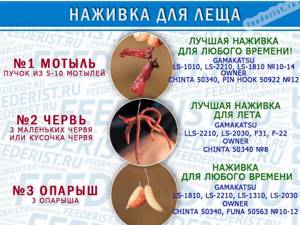
The best vegetable baits for bream
Vegetable baits are used in the warm season, when the water warms up above 15 degrees. The advantage of plant-based baits is that they can be prepared from products available at home. The best vegetable baits for fishing bream are:
- pearl barley;
- Hercules;
- semolina dough;
- peas;
- corn.
Pearl barley is a bait that holds securely on a hook, so it is often used when catching bream using bottom gear. Small fish do not like this bait, which makes pearl barley a good bait for catching trophy bream.
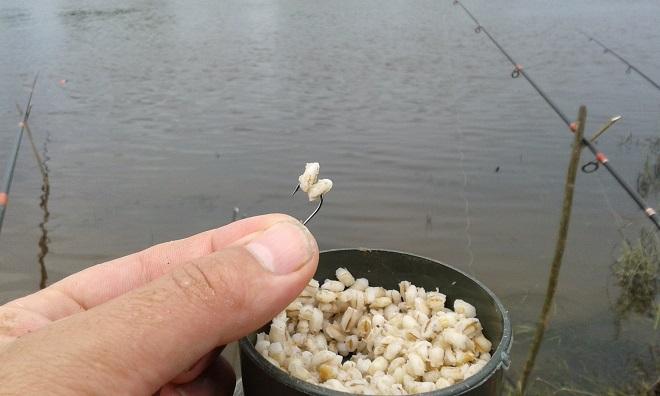
Fishermen often make a mistake when preparing cereals: pouring a large pan of water and pouring a handful of pearl barley into it - this is wrong. The cereal should be boiled in a small amount of water, stirring constantly and making sure that the contents of the pan do not burn, since even a faint burning smell can alert the fish. Cooking time is 50 minutes (after water boils). By the end of cooking, the liquid in which the pearl barley is cooked should be a mucous substance that generously covers the cooked grains. The grain prepared in this way, once in the water, will form a cloud of turbidity around itself, which additionally attracts fish.
The taste buds of bream are located on the outer side of the lips and before swallowing the bait, the fish tastes it, so during the cooking process a little sugar or honey is added to the barley. To enhance the attractive effect, boiled grains can be rolled in powdered milk or baby food. Place 2–3 large grains on the hook. The optimal hook number is 8–4.
Hercules is an effective bait for bream in the summer season, which is useful when the fish feeds not from the bottom, but in the water column. The process of preparing rolled oats consists of three stages:
- oatmeal is poured into a fine-mesh colander;
- scalded with boiling water;
- pour onto a dry cloth to dry.
After scalding, the rolled oats become viscous on the outside and dry on the inside, which allows them to stay securely on the hook and at the same time increases their buoyancy. The grain attached to the hook slowly sinks into the water column and provokes the bream to bite. For fishing with Hercules, light hooks are used to ensure a slow fall of the bait.
Semolina dough - bream loves this bait in mid-summer, when the water temperature exceeds 20 degrees. The attachment is mixed using semolina and water. During the kneading process, honey or sugar syrup is added to the dough. To give the bait an attractive aroma, add a little cinnamon powder. The viscosity of the dough can vary and depends on the strength of the current at the fishing site. The stronger the current, the more viscous the nozzle should be. For such plant baits, hooks are used that are equipped with a small spiral attached to the shank. This spiral prevents the bait from flying off during fishing.
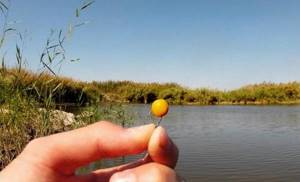
Peas - used as bait, and also as bait for bream in the summer. After an hour and a half of cooking, the dried peas become soft and can be easily placed on the hook. Some anglers use pea dough for bream fishing, which is prepared as follows:
- peas are cooked for 2 hours;
- cools down;
- grinds into porridge;
- mixed with a small amount of flour;
- knead in your hands until a homogeneous mass is obtained.
On the shore of the reservoir, a ball with a diameter of 1–1.5 cm is formed from the resulting dough, which is placed on a hook No. 8–4.
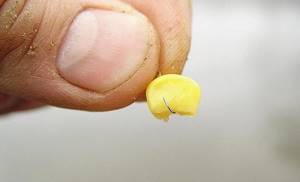
Corn – This bait helps weed out small fish and is a favorite of bream.
For fishing, it is preferable to use canned sweet corn. Before attaching to the hook, the grain must be slightly mashed so that it produces juice that attracts fish with its aroma. 1-3 grains of corn are placed on hook No. 6-2. The liquid contained in the jar can be added to the bait mixture.
Vegetable baits for catching bream
Vegetable baits also work very well when fishing for bream. Bream responds especially well to them in the summer. In general, the bream bite is weak in summer, but vegetable baits can awaken the appetite of even passive fish. In spring and autumn, animal baits will work better, but it happens that bream refuses to bite on a worm, but happily takes on corn. So, vegetable baits should be with you on every fishing trip, along with animal baits.
The variety of plant baits for catching bream is impressive. Among the most effective and popular are the following:
- semolina, dough;
- corn;
- peas;
- pearl barley.
Semolina or dough. Semolina, or semolina, is excellent for catching bream on a float rod. In the daytime, fishing for bream using semolina or dough can be interfered with by other white fish, especially small fish, but when fishing in the dark, it’s mostly bream that bite. You may also find carp, crucian carp and other fish, but at night these are usually large specimens. For fishing with a feeder or donk, such a bait is of little use, since it does not hold well on the hook.
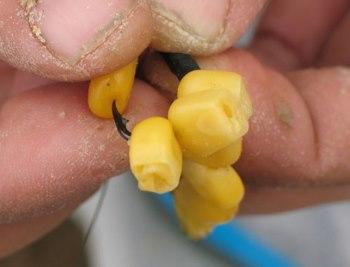
Corn. To catch bream, you use canned corn, which is sold in any grocery store. This is one of the most popular baits for bream, which cuts off the bite of many small fish, but, nevertheless, silver bream, roach and crucian carp will also bite on it. It is universal, as it can be used for both a float rod and a feeder.
Peas. You can also buy canned peas, but it is better to cook them yourself. Bream usually take peas more actively and confidently on peas prepared on their own. It cuts off bites from almost all small fish, which is why anglers really like it as bait. To catch bream with peas, it is better to use a hair rig - it will allow you to make more effective hooks, and often the bream will hook itself, due to the fact that the hook will be bare and easily enter the tissue of the fish that pecked. It is also used both for float fishing for bream and for feeder fishing.
Pearl barley. A universal attachment that will catch bream, silver bream, roach, crucian carp and other peaceful fish.
At night it will attract all carp fish. Small fish are reluctant to bite on pearl barley, so they won’t be too annoying. If you want to catch bream along with any other passing fish, pearl barley is a good option.
Artificial baits
Some fishermen use artificial baits when fishing for bream. One of these baits are foam balls. The balls are painted with a marker in different colors and placed on a hook. Such bait is effective only when the bream is actively biting, when the fish greedily rushes to any object that even remotely resembles natural food.
Another artificial bream bait is foam balls, painted with food coloring and impregnated with flavoring. The foam ball holds securely on the hook, and the flavor used provokes the fish to bite.
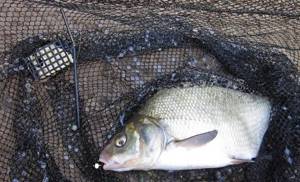
With the advent of “edible” rubber, bream began to often be hooked by spinners. To catch bream with a spinning rod, artificial imitations of worms and leeches are used. The length of such baits ranges from 3 to 5 cm.
Homemade bait recipes
For bream you need to prepare a lot of bait .
You should always have some supply with you, since fishing can be activated and you will have to feed the future trophy with something. When fishing with a donk and a feeder, use feeder weights, and when fishing with a float, make balls. In specialized stores, ready-made bait is sold, but it is not cheap, and given the fact that you need a lot of it, the pleasure can hit your pocket. The simplest and cheapest option is to prepare bait at home.
The best ways to cook homemade catch bait:
Excellent bait, attracts bream during feeder fishing. It works ideally in the fall (it’s convenient to fill the feeder weight with donks) and in the winter when fishing from ice.
Recipe No. 1:
- Boil oatmeal and millet over low heat During cooking, you need to make sure that the mixture does not burn, as there will be an unpleasant smell.
- Further preparation continues at the fishing site.
- Clay or sand is added to the porridge so that the cereal holds its shape.
- to the finished mixture .
- Small balls - 5-6 pieces - are molded from the resulting mixture
Recipe No. 2:
Super bait, works well as bait. You can prepare the mixture with your own hands even on the day of fishing; it is ready in 1 hour.
- The bait is done immediately before fishing.
- Mix bran , sunflower cake, corn sticks or flakes, coffee drink, bloodworms and maggots in a bowl.
- Water from a pond and clay are added to this mixture, and everything is kneaded until it becomes a thick dough. You can let the bait sit for a few minutes.
- Then the balls are molded and thrown into the water. While fishing, you can make very small balls and throw them into the water to keep the fish in place.
Recipe No. 3:
An old grandfather's bait that makes bream bite even in ponds with no current.
- On the shore of the reservoir, the following ingredients are mixed in one bowl: steamed peas, bran, flax seeds (fried), egg powder, fresh grated beets, worms, maggots, clay.
- After kneading, balls are made and sent into the water.
Experienced fishermen always experiment with bream food.
But there are universal mixtures that work under almost any conditions. Recipe:
- In a saucepan you need to boil 3-3.3 cups of water.
- Add 2.5 cups of pearl barley to boiling water It must be cooked until half cooked.
- After the pearl barley swells, millet is added.
- to add flavor .
- The porridge should be cooked until most of the water has evaporated.
- After this, turn off the pan and cover with a lid and leave for 40-45 minutes so that the remaining water is absorbed into the cereal.
- After this time, the porridge must be transferred to another container.
- Add 3 cups each of barley and corn to the warm mixture
- At the fishing spot, you can already add clay and water for better mixing.
Adviсe:
- Barley and millet groats cannot be replaced with anything.
- Instead of barley and corn grits, you can use crackers, cake, and store-bought bait.
When fishing from a boat, for example, using a ring, use regular feeder bait. It has all the necessary elements so that the feeding balls do not disintegrate before they reach the bottom.
Other baits
On small rivers, bream can be caught well with caddis flies. This bait can be collected from the bottom of the reservoir where fishing takes place. In the spring, when active flight of insects occurs, fish often prefer the dragonfly larva, the goose, to other baits, which can be collected on the grass growing in the coastal zone.
The bark beetle is a catchable bait that lives in rotten stumps and under the bark of fallen trees. Barley shell meat can also be used as bream bait. Fresh wheat bread placed on a hook often provokes fish to bite.
To catch trophy specimens, bream fishing uses boilies designed for carp fishing. Large bream can be caught using pellets. This bait is fixed on the hook using a special elastic band.
Bait for winter bream
In winter, bream is inactive, eats little and feeds on animal organisms from the bottom. It follows from this that the amount of bait for catching it should be small. Important question! Should I add bloodworms or maggots to the bait?
If there is a large amount of ruffe in the reservoir, then it is better to refuse to use bloodworms in bait. A cloud of larvae in the porridge can do exactly the opposite, luring a flock of unwanted ruff. In such cases, it is better to try fishing with plant baits.
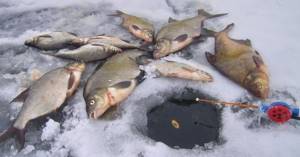
As bait you can use millet, pearl barley and pea porridge with various additives, for example makukha. There are also ready-made winter baits for fishing from the bottom. If the fishing area is deep or has a strong current, we recommend lowering the bait with special feeders. Otherwise, the ball of bait may be carried too far from the axis of the hole, and the bream will not find your bait.
Lure sandwiches for bream
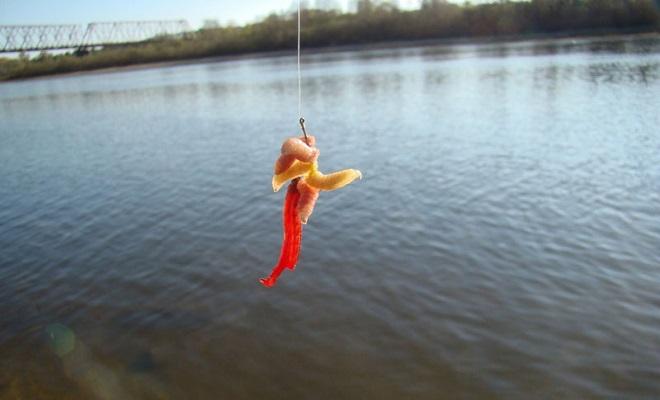
To deceive the fish, anglers often have to resort to tricks, which consist of a combination of various animal and plant baits. The most catchy “sandwiches” for bream are the following combinations of baits:
- maggot with bloodworms;
- maggot with worm;
- pearl barley with bloodworms;
- corn with worm;
- semolina with pearl barley.
When fishing, you can use combinations consisting of not only two, but also three elements. Constant experimentation with different types of attachments and their combinations often brings the desired result.
General rules for selecting bait
They look like this:
- Advantage is given to animal components.
- The classic option is a bunch of red dung worms threaded through the center of the hook. The wriggling movements of such a bait can attract bream from a long distance.
- Bait made from several maggots or large bloodworms works great.
- If the bite is weak, it is better to use “buters” - a combination of maggots and bloodworms, maggots and dung worms.
- Bream reacts to the meat of toothless fish and pearl barley. But only in those reservoirs where such a food supply lives.
- There are reviews from fishermen about the effectiveness of pieces of smoked lard placed on a hook.
When going fishing, it is important to always take into account weather conditions and atmospheric pressure levels. Fish are very sensitive to any sudden changes. Even with the presence of excellent complementary food, the bait may simply not bite.
September
This period is marked by an intensification of biting. The best time for fishing is considered to be early morning or evening before sunset. Suitable weather is clear, without strong winds or cloudy with light rain. It is better to use bait of a small fraction, so that the bream remains at the desired fishing point for a long time and does not have time to eat.
The working attachments in September will be:
- earthworm, dung worm;
- maggot;
- various types of dough;
- large grains (barley, peas, wheat);
- bread pulp.
Fishermen who live near a reservoir practice feeding at the same fishing point every day. Thus, the chances of catching a trophy increase significantly.
October
The activity of individuals decreases. Since most of the specimens managed to accumulate a sufficient amount of useful substances during September. Bream spends no more than 4 hours a day searching for and eating food. And with a sharp drop in temperature, it gathers in flocks and sinks to depth. By the end of October it lives exclusively from the bottom. All types of bottom rigs in which the bait reaches the bottom become workers.
The following animal baits should be placed on the hook:
- bloodworm;
- worm.
The maggot becomes less effective. Add crushed animal components to complementary foods. They contain a lot of protein, which is necessary for fish to survive the winter comfortably.
November
With the onset of November, you need to look for bream at great depths of up to 15 m near sharp changes in the bottom. During this period, fish accumulate near wintering pits. This is due to the fact that the greater the depth, the longer the water temperature does not drop to low levels. The bite is unstable. Bait and groundbait should contain a maximum of animal components (worms, maggots, bloodworms).
Purchased mixtures are selected exclusively for cold water. Suitable brands:
- Sensas;
- Dunaev;
- Trapper.
The presence of a portable echo sounder attached to the boat will speed up the search for a school of fish. When casting from the shore, you need to take a longer rod with a marker float (to determine the working depth).
Features of choosing bait by season
The choice of bait depends greatly on the time of year. In cold water, vegetation is poorly developed, so in spring and autumn, fish are forced to feed on aquatic insects and invertebrates. As the water warms, aquatic vegetation begins to develop rapidly and by the beginning of summer it makes up a significant part of the bream’s diet. However, large specimens prefer protein-rich animal food, as it allows them to quickly accumulate the necessary fat reserves. For fishing to be successful, the angler must understand what bait to use depending on the time of year.
Bait in spring
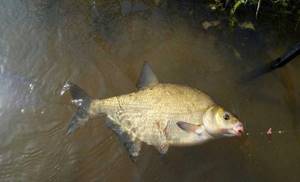
A dung worm or crawler is the best bait for bream in the spring. This is due to the fact that most flowing reservoirs experience high water in the spring. The rapid flow of water washes away the earthen banks, and worms fall into the water along with the earth. The fish quickly gets used to such food and prefers the worm to other baits. Active fishing of bream on a worm continues until the end of the flood.
In mid-spring, maggots show good results. Closer to summer, fish begin to pay attention to pearl barley and corn.
Bait for bream in summer
In summer, plant baits work better. In June, fish prefer to bite on the following types of bait:
- Hercules;
- peas;
- bread;
- pearl barley
In July, semolina dough flavored with sweet flavors begins to work well. At the end of the summer season, the fish prefer maggots.
Bait for bream in autumn
Dung worms and maggots are the most catchy baits for bream in the fall. At the beginning of autumn, the fish still pays attention to plant baits, but by the middle of the autumn season it completely switches to animal food, trying to accumulate more fat before wintering.
Bait in winter
Bloodworms are the main bait for bream in winter. In addition to bloodworms, fish bite on worms and maggots, as well as semolina dough mixed with beef blood.
Fertilizer and its composition
With the onset of cold weather, the taste preferences of bream change significantly, unlike in summer. This is directly related to the gradual decrease in the food supply. To save time, many fishermen who are new to this business purchase ready-made mixtures in the store. On the shelves you can often see ready-made packs of bait labeled “for cold water” - this is an excellent option for fishing in mid-October - early November.
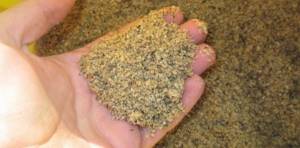
But avid lovers prefer to prepare complementary foods themselves according to recipes that have been proven over the years. Other fishermen believe that a combination of store-bought and homemade bait will bring greater results. Regardless of the chosen option, when fishing with a feeder, it is important that the bait from the feeder does not fall apart ahead of time, but successfully reaches the required casting point.
Cold water will prevent the mixture from quickly disintegrating into particles, but to be safe, it is better to strengthen the composition with special additives. And the finished balls should have a fairly dense consistency. With standing reservoirs the situation is the opposite - you will need a composition that can be easily washed out with water.
IMPORTANT! If it so happens that the fishing will be on the river, and you have a purchased mixture for fishing on the pond with you, then you should not reel in your fishing rods ahead of time. It is enough just to add a little coastal clay to the composition - it will increase the density of the consistency, and the complementary food will be washed out of the feeder gradually. When, on the contrary, it is required that the balls disintegrate faster in water, then river sand is an excellent assistant for this.
Making your own complementary foods
We recommend taking into account several important points:
- When the temperature drops significantly, the working mixture becomes saturated with animal components (chopped worms, bloodworms, maggots).
- An excellent complementary food for bream comes from a combination of porridge and cake.
- When using fragrances, use only alcohol-based ones. Since they are oil-based, they do not dissolve in cold water and it will be a waste of money.
- Mixtures with the aroma of cocoa and molasses work well in the fall.
- Starting from September, bream readily responds to pearl barley and mastyrka.
- From October it is better to try combining several animal ingredients. At night and in the evening, large fish respond more actively to the worm, during the day and in the morning - to sandwiches of bloodworms and maggots.
It is important to understand that bream is not the only animal lover of complementary foods. Therefore, taking a maggot or a worm as a basis, do not be surprised if you manage to catch a decent ruff, perch or even roach as a catch. There is no exact list of complementary foods that are guaranteed to bring results. Selection is carried out individually depending on the type of reservoir.
Don't forget about boilies. Use in strictly recommended dosage. Although they are less effective in cold water than in summer, when combined with animal bait they bite quite well. When purchasing ready-made mixtures, it is important to pay attention to the recommendations for use indicated on the packaging and not neglect them.
Fragrances for baits
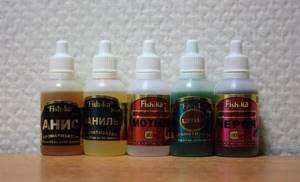
Bream has a good sense of smell, so to make the bait more attractive, anglers use flavorings. In summer, fish respond better to sweet aromas. In cold spring and autumn water, baits are flavored with spicy aromas with the smell:
- pepper;
- coriander;
- caraway;
- curry.
In winter, you should not resort to using any flavorings, since in the purest winter water, fish are very wary of strong odors.
Animal species
The use of animal options will be no less successful; many subspecies on a hook will be able to attract the attention of ichthyans, sometimes even better. There are quite a few options, and everyone will work on a separate body of water in a special way.
Worm
The most common animal bait is the worm; with its help you can attract not only peaceful fish species, but also some predators. A worm as a bait for bream in the summer is of little relevance, but with the arrival of autumn it is precisely this that will allow you to catch trophy specimens.
It is important to use the worm in early spring, mid and late autumn. This bait for bream in the summer will bring good results at night, and in the winter a representative of the carp species will enjoy it with pleasure at any time of the day.
Maggot
This subspecies holds a hook well and is an excellent bait option for catching any peaceful fish throughout the year. A few larvae on the hook will help keep small fish away from it, but a trophy specimen will definitely not pass by. The main thing is to know how to place maggots on a bream hook correctly; the result of the catch in any body of water largely depends on this.
In winter, fish rarely react to maggots; the best delicacy during this period will be a mosquito larva; cyprinids take it more readily.
Bloodworm
The mosquito larva is considered a universal bait option for residents of reservoirs with both flowing and standing water. Use both in winter from ice and in open water will bring excellent results. Bloodworms are usually attached in two ways:
- directly onto a hook made of thin wire, and the product is selected in a small size;
- in a bunch, having previously secured several larvae with an elastic band.
The second option is more suitable for the end of spring, summer and autumn, but they fish with a small hook only in winter.
Other animal options
The dragonfly larva is also attractive to the cunning resident of the reservoir; it is placed on a larger hook, and only large individuals are caught. Good results will be achieved by caddisfly, leech-klepsing, and toothless pieces.
Some experienced fishermen fish for lard, using unsalted fresh lard, cut into small pieces.
Using each option will bring success, but you should not strictly adhere to the recommendations. Experiments often yield greater catches than strict adherence to rules.
Summer Bream Bait - Determining a Successful Bait
The fact is that bait for large bream works differently in summer. Even if you rely on water temperature, it is quite difficult to determine a uniquely successful option. Therefore, when preparing for fishing, you should not stop at just one type of bait. If something worked yesterday, it may no longer attract fish today.
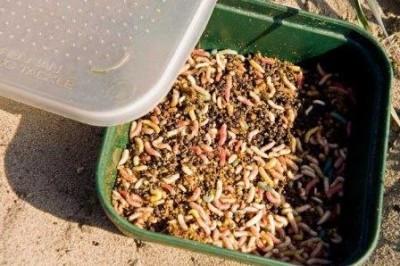
It is a wise decision to take both plant and animal bait. If you have several gears, you can equip them differently. Place a worm on one hook and plant bait on the other. The first hour of fishing will show which option is better that day.
After this, it will be possible to abandon the ineffective species and use exclusively catchable bait. Careful preparation will increase the chances of a good catch.
If the choice of bait is limited, then it is best to give preference to the red dung worm. It is a favorite delicacy of many fish, so even if bream avoids your hook, crucian or carp certainly will not resist.
Catching bream with a tackle with a feeder
Very popular feeder fishing using feeders allows you to catch trophy-sized bream. This method combines the effects of bait and bait as effectively as possible. It is very good to fill the feeder with boiled porridge. It is viscous and holds inside better. Flavored plasticine made from grain mixtures, which is sold in fishing stores, performs well.
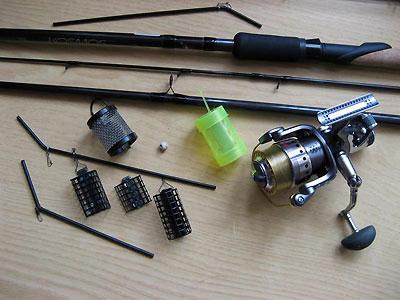
Instead of bait, hooks can be equipped with boilies or foam. The bream, sucking the bait from the feeder, simultaneously swallows the hook, after which the hooking itself occurs.
This method is effective not only in summer, but also in autumn. You can equip hooks with live bait, without placing them inside the feeder. In this case, the fish purposefully grabs the hook, which doesn’t make much difference.
Bream is a smart and cautious fish, but having an arsenal of tasty baits and baits you can always count on a good catch.
Bait for bream in summer - Using groundbait
As bait for bream, you can use mixtures that are sold in fishing stores specifically for this purpose. To do this, you need to collect water from the reservoir where fishing takes place and pour it into the dry mixture for bait. The amount of liquid must be adjusted so that the resulting mixture easily forms into balls. To increase the effectiveness of bites, it would be useful to add a little bait and mix.
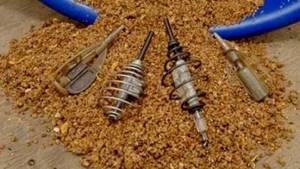
The presence of bait in the bait leads to the fact that the fish, after trying several pieces, loses its vigilance. As a result, it is quite possible that next time the hook will be swallowed.
Bream is one of the smartest and most cautious river fish; it quickly learns to recognize the tricks of fishermen. Therefore, in order to outsmart him you have to resort to tricks.
Balls with bait can be thrown into the fishing point by hand, using a slingshot, a radio-controlled boat, or swimming in a boat. You shouldn’t overdo it, because the school of fish will quickly get enough and a bite won’t happen.
Making your own bait
An alternative to professional mixtures from a fishing store are homemade baits. First of all, sunflower cake shows itself well. It does not require any preparation and all you need to do is soak it. Finely crushed cereal grains can be used. It is not necessary to cook them, but porridge would be preferable. You can use the following cereals:
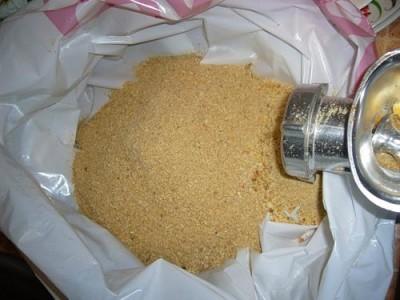
wheat;- pearl barley;
- rye;
- cereals;
- corn;
- soybean, etc.
Bream has a weakness for the aroma of vegetable oil. You can add flavorings to the mixture. The smells of anise, sunflower oil, caramel, vanilla, garlic and fruit essences give good results. Having made a mixture of cereals, you can steam it, boil it, or simply mix it with water from a reservoir.


